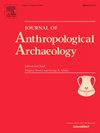恢复流动性的实质性景观
IF 2.2
1区 社会学
Q1 ANTHROPOLOGY
引用次数: 0
摘要
本特刊探讨了一个复杂的问题:在流动性塑造的主体背景下谈论身份认同意味着什么?考古学能够提供哪些其他领域可能忽略的见解?这一问题是考古学和历史考古学的核心所在,长期以来,考古学和历史考古学一直在努力解决考古记录中所反映的各种流动性和身份问题。正如本期所展示的,这些研究不仅仅是学术活动--它们回应了当代全球关于移民的争论,在这些争论中,物质证据往往被政治化以构建 "他人"。这些论文展示了跨越不同尺度的流动是如何重塑地理格局并揭示过去主体所经历的摩擦的。这种研究方法超越了单纯的个人经历复原,而是对使社会等级合法化的意识形态结构进行了拷问。通过关注过去人类流动的多样性及其物质遗产,作者认为考古学可以为理解作为人类历史复杂驱动力的移民做出重大贡献。最终,这本文集强调了探索这些知识实践如何与全球财富不平等以及全球南北之间无风险流动性相交织的必要性。本文章由计算机程序翻译,如有差异,请以英文原文为准。
Recovering a substantive landscape of mobility
This special issue explores the complex question: What does it mean to talk about identity in the context of subjects shaped by mobility, and what insights can archaeology provide that other fields may overlook? This inquiry lies at the heart of both archaeology and historical archaeology, which have long grappled with the diverse mobilities and identities reflected in the archaeological record. As this issue demonstrates, these studies are more than just academic exercises—they respond to contemporary global debates on migration, where material evidence is often politicized to construct “others.” The papers demonstrate how mobility, enacted across various scales, reshapes geographies and reveals the frictions experienced by past subjects. This approach moves beyond mere recovery of individual experiences to interrogate the ideological structures that legitimize social hierarchies. By focusing on the variety of past human mobilities and their material legacies, the authors suggest that archaeology can contribute significantly to understanding migration as a complex driver of human history. Ultimately, this collection highlights the need to explore how these intellectual practices intersect with global inequalities in wealth and risk-free mobility between the global north and south.
求助全文
通过发布文献求助,成功后即可免费获取论文全文。
去求助
来源期刊

Journal of Anthropological Archaeology
Multiple-
CiteScore
4.00
自引率
11.10%
发文量
64
期刊介绍:
An innovative, international publication, the Journal of Anthropological Archaeology is devoted to the development of theory and, in a broad sense, methodology for the systematic and rigorous understanding of the organization, operation, and evolution of human societies. The discipline served by the journal is characterized by its goals and approach, not by geographical or temporal bounds. The data utilized or treated range from the earliest archaeological evidence for the emergence of human culture to historically documented societies and the contemporary observations of the ethnographer, ethnoarchaeologist, sociologist, or geographer. These subjects appear in the journal as examples of cultural organization, operation, and evolution, not as specific historical phenomena.
 求助内容:
求助内容: 应助结果提醒方式:
应助结果提醒方式:


